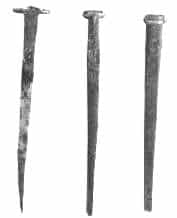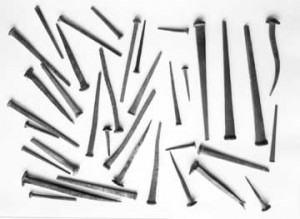System for Dating Country & Primitive Furniture, Part2
The Business of Doing Business in Antiques – The Journal of Antiques and Collectibles – August 2002
Technological System for Dating Country and Primitive Furniture Part 2
Continued from part 1
Jay D. Edwards and Tom Wells, researchers from Louisiana State University, have published a working paper on historical nail technology. Their work chronicles the development of nail technology from 1720 to 1900. The study was undertaken to help historians pinpoint the precise construction dates of historical buildings. The authors’ systematic chronological presentation of the subject includes many photographs and drawings that transform complicated technological research into an easy to read and understand subject.
They begin by explaining the three ways in which nails are made: by forging, by cutting, and by drawing. Forged nails are hand shaped one at a time by a blacksmith. After the shaft is shaped, it is placed into a heading tool and the head is formed with several blows of a hammer. This process produces what is commonly called the Rose Head nail.
Cut nails are made in a two-step process. First, blanks are cut from flat strips of iron. Second, the nail is held tight while the head is formed by the blow of a mechanical heading device.
Drawn nails are made by pulling wire through a series of dies. Die sizes, of course, determines nail size. The wire nail is then held in a clamp and headed in a separate process. Although drawn nails were experimented with in France in 1820 and in New York State in 1855, it was the development of Bessemer steel in 1885 that made the drawn nail feasible.
Edwards and Wells have sorted the many types of nails into twelve easy to understand groupings. Groups 1 and 2 are nails made entirely by hand. These nails are the ones that antique dealers call Rose Head nails. The reason for dividing handmade nails into two groupings is that two different forming methods were used. A close inspection of a handmade nail will often reveal the method used and therefore its approximate age.
At the other end of this scale is group 10, a square cut steel nail introduced in 1885 that had a short life span because it was almost immediately replaced by the wire nail.
Groups 11 and 12 are a detailed examination of the modern wire nail that came into use in 1880 and by 1900 had displaced the cut square nail.
Of the seven remaining groupings, nails in groups three, four, five, six, and eight are the most common nail used to fasten together American country and American primitive furniture. These nails were cut then headed by machines. There are many easy-to-see differences in each of these five styles. Antique dealers who learn to recognize these five styles of nails can date country and primitive furniture to within a twenty-year period and by combining nail technology with those of hinges, screws, latches, saw marks, and plane marks can pinpoint the actual construction date to within ten years.
Machinery leaves telltale marks on the piece it makes. In the case of machine cut nails, the shaft of each nail will exhibit cutting marks where the nail is stamped out of a sheet of iron in much the same manner as a cookie cutter works.As the nail cutter slices through the nail plate it rounds the top face and leaves a burr on the bottom (or back) of the nail.Nails cut in this cookie cutter fashion were made from 1790 to 1890.
The first nail making machines were crude and lacked power. The nail stock had to be turned over because the cutting blades could only cut one side at a time. This process left a cutting burr on each side of the nail shaft.Nails with opposite side burrs were made from 1790 to 1835.
Besides cutting marks, the nail shaft will also exhibit clamp marks near the head where it was held tightly so that the head could be formed by a heading machine. Early heading machines grabbed the nail from the side and left quite a noticeable imprint when it did so.
After 1835, a new method of heading nails was employed and this machine grabbed and held the nail on its face leaving a recognizable indentation on the face.This one bit of information can help date cupboards to before or after 1835. Typically, side pinched nails date 1790 to 1835; face pinched nails date 1835 to 1890.
Wrought iron has a grain much as wood has a grain. Hand forged Rose Head nails were made with the grain running lengthwise of the nail shaft. However, when nails began to be stamped out of flat sheets of wrought iron, it was found that the cutting machine did not work well with the in-line grain. Therefore, early machine cut nails were cut across the grain. This process produced an inferior nail that could not be clinched but their low cost far out weighed this disadvantage.
Consequently, from 1790 to 1848 the grain of a machine cut nail runs across rather than with the length of the shaft. In 1848, a new machine was introduced that cut nails, once again, in-line with the grain of wrought iron. This machine was used until steel replaced wrought iron in 1885.
Using the above information nails can be dated as follows: A cut nail made out of steel dates 1885 and later. A cut nail that has opposite side (face and back) cutting burrs, is side pinched, and has a grain that runs across the shaft dates 1790-1848. A nail that has cutting burrs on the same side, is crossed grained, and side pinched dates 1835-1848. A cut nail that has in-line grain, is faced pinched, and cutting burrs on the same side dates 1848-1885. There are many other combinations, too many to include in an article of this nature. Dealers and collectors should contact Louisiana State University for a copy of this research paper. It is cheap!
The full name of the research paper written by Edwards and Wells is Historic Louisiana Nails – Aids to the Dating of Old Buildings. The cost is $20 and this price includes postage and handling. Make your checks payable to Geoscience Publication P.O. Box 16010 Baton Rouge, LA 70893-6010.
You can also order online at http://www.ga.lsu.edu/k2.html/
Images:
Common eight penny nails used in house and furniture construction. The one on the left was hand wrought and hand headed either by a professional nailer or by a blacksmith in the 1700s. Most antique dealers and collectors can easily recognize this style nail (the Rose Head). The nail in the middle was made between 1790 and 1835. The shank of this nail has opposite side cutting burrs because the stock this nail was cut from was rotated 1808 between each cut. The nail is severely side pinched under the head. This deformation was caused by the heading machine clamp pinching the shaft at this point to hold it securely so that the head could be formed. The nail on the right was made between 1835 and 1885. The cutting burrs are on the same side of the nail shaft. Same side burrs are evidence of an improvement in nail technology implemented in 1835. The entire nail was cut in one operation. It was no longer necessary to rotate the stock between each cut. The heading machine grabbed this style nail by the face to hold it so that the head could be formed. Notice there is no side pinching underneath the head.
These nails represent American nail technology from the early 1700s until 1900. These nails look different because they are different. Each type was made by a slightly different process using new technology as it advanced.The ability to identify nails and the period in which they where made makes it possible to date accurately the construction period of anything fastened together with nails. This process works for a chest of drawers, a cupboard, or for a house.
1 thoughts on “System for Dating Country and Primitive Furniture, Part Two”
Leave a Reply
You must be logged in to post a comment.








Pingback: System for Dating Country and Primitive Furniture, Part One | The Journal of Antiques and Collectibles